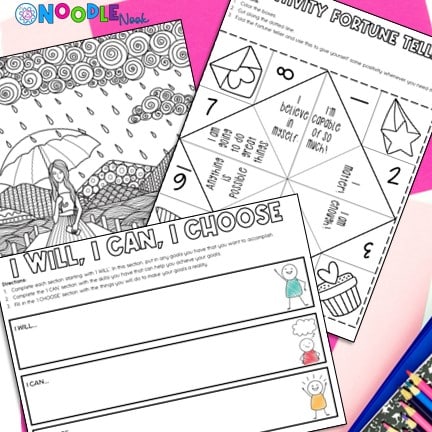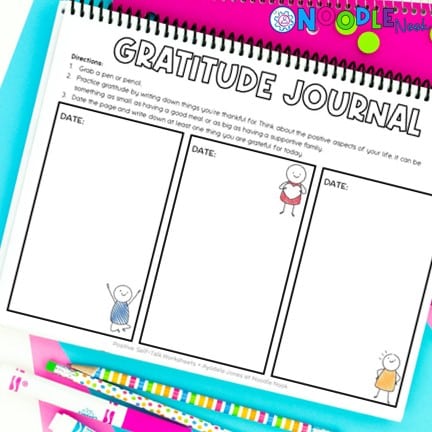Now more than ever, we, as teachers, need tips and strategies on how to promote positive self-talk in students. Positive self-talk is an important skill. Getting better at positive self-talk can directly impact the long-term mental health and well-being of our students. In this post, you’ll find some tips and strategies on how to promote these skills in students as well as positive self-talk worksheet ideas to use with your students. Before we dive into that, let’s take a moment to reflect on our own negative self-talk.
As teachers, we often put a lot of pressure on ourselves to be perfect and to have all the answers. It’s easy to get caught up in negative thoughts such as “I’m not good enough” or “I’m not doing enough.” But the truth is, we are all human and we all have moments of doubt and insecurity. The first step in promoting positive self-talk in our students is to be mindful of our own negative self-talk. Then we need to actively work to reframe those thoughts into something more positive. Let’s work together to create a positive and supportive classroom environment for our students and for ourselves.

What is Self-Talk?
Self-talk refers to the internal dialogue that we have with ourselves. This can be either be conscious or unconscious. We all use self-talk to problem-solve and make decisions. In fact, modeling how to do self-talk with students as part of attacking complex tasks or understanding complicated ideas is extremely helpful in the classroom. Self-talk encompasses all that internal dialogue. It includes all the thoughts, images, and beliefs that we have about ourselves and the world around us. Self-talk can be either positive or negative, and it can have a significant impact on our mental health and well-being.
Negative self-talk refers to the thoughts and beliefs that we have about ourselves that are negative, critical, or self-defeating. These thoughts can take many forms. Things like “I’m not good enough,” “I’ll never be able to do this,” or “I’m a failure.” Negative self-talk can lead to feelings of low self-esteem, anxiety, and depression. They can also hold us back from achieving our goals.
Positive self-talk, on the other hand, refers to thoughts and beliefs that are positive, supportive, and empowering. Positive self-talk can take many forms. Things like “I am capable,” “I am strong,” or “I can do this.” Positive self-talk can help to boost our self-esteem, confidence, and motivation. It can also help us to achieve our goals.
It is important to note that negative self-talk is something that many people experience. It’s not a sign of weakness or a lack of willpower. It is a normal human experience, and it can be changed with effort, practice, and patience.
5-Steps to Positivity
Knowing that self-talk is one of the most powerful tools we have for influencing our emotions and thoughts. Now we need to know how to support students (and ourselves) to transform negativity into positivity.
Self-talk can be used to promote positivity and well-being, or it can be used to bring us down. Learning how to turn negative self-talk into positive self-talk is an essential like skill. It’s important for anyone who wants to improve their mental health and well-being.
There is a simple yet effective five-step process that can turn negative self-talk into positive self-talk. These steps are easy to follow and will help you to reframe your negative thoughts and promote positivity in your life. By following these steps, you can help students to develop a more positive outlook on life. You can also help them to achieve their goals with more confidence and motivation.
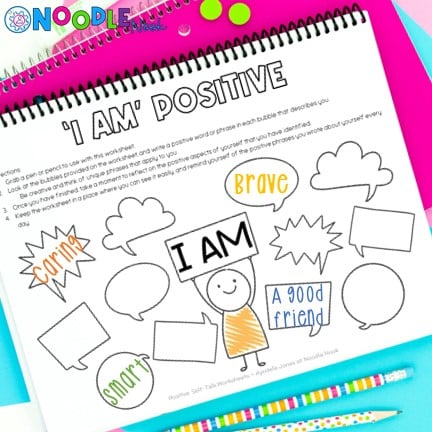
1. Recognize Negative Self-Talk
The first step to turning negative self-talk into positive self-talk is to become aware of when it occurs. To do this, you can take some time each day to reflect on your thoughts and identify patterns of negative self-talk.
Thought Diary
One strategy that can be helpful is to keep a thought diary. This is a journal where you can write down any negative thoughts that come to mind throughout the day. Once you’ve identified a negative thought, take the time to analyze it. Why are you feeling this way and what was the trigger? Recognizing the negative thought and the trigger will go a long way to turning negativity into positivity.
Thought Stop
Another strategy that can be helpful is to create a “thought stop” signal. This can be a specific word or phrase that you can use to interrupt negative thoughts when they arise. For example, you might choose the word “STOP” as your thought stop signal. Every time you notice a negative thought creeping in, you say “STOP” to yourself and then consciously refocus your attention on something positive.
Be Non-Judgemental
It’s also important to encourage students to identify negative self-talk in a non-judgmental way. As they identify negative thoughts, they should be reminded that having negative thoughts is normal. It’s not about getting rid of them, but learning how to manage and reframe them in a more positive way. Encourage them to be patient with themselves. It takes time, practice, and patience to replace negative thoughts with positive ones.
2. Challenge Negative Thoughts
Once you have identified a negative thought, it’s essential to take the time to question its validity.
5 Whys Technique
One strategy that can be helpful is to use the “5 Whys” technique. This involves asking yourself “why” five times in a row until you get to the root of the thought.
For example:
- “I’m not good enough” – Why?
- “Because I didn’t do well on the test” – Why?
- “Because I didn’t study enough” – Why?
- “‘Cause I was too busy” – Why?
- “Because I didn’t prioritize my time correctly” – Why?
- “Because I was procrastinating”
This simple worksheet is an excellent way to take the inner critic and build better self-esteem. It’s done by looking for the behavioral causes of our negative thoughts as opposed to connecting them to a negative self-referential schema where there is something ‘wrong’ with us.
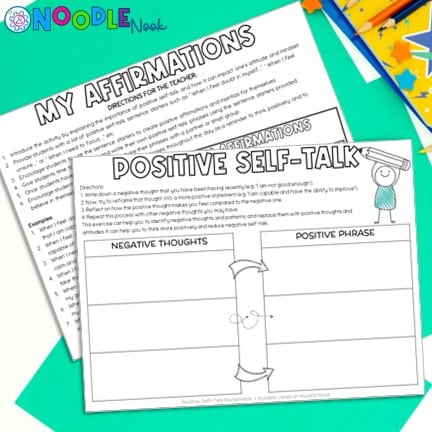
Thought Record
Another strategy is to use a thought record, where you write down the negative thought, evaluate the evidence for and against it. Then reframe it in as a positive statement. Reframing negative thoughts is a great strategy to teach students, making this positive self-talk worksheet a powerful one.
Knowing how to reframe negativity into a more positive message can support a child throughout their life. For example, instead of saying “I’m not good enough,” you could say “I am capable and have the ability to improve.” This simple change in perspective can help you to see things in a more positive light. It can also focus on strengths and abilities rather than limitations.
Positive Phrases
Incorporating positive affirmations or positive phrases can also be very helpful. Encourage students to create positive affirmations or mantras that they can repeat to themselves when they are feeling down. These can be simple phrases such as “I am worthy,” “I am strong,” or “I am capable.” Encourage them to repeat these affirmations to themselves whenever they have a negative thought.
It is important to remind students that these strategies take time and practice to be effective. It’s normal to slip back into negative self-talk at times. Encourage them to be patient with themselves and to keep trying different strategies until they find what works for them.
3. Practice Positive Self-Talk
Once you have reframed a negative thought, it’s important to replace it with a positive one and to repeat this positive thought to yourself throughout the day. This will help to reinforce the new positive thought and to make it more ingrained in your mind.
Positive Affirmations
One strategy that can be helpful is to create a list of positive affirmations that you can repeat to yourself when you are feeling down. These can be simple phrases such as “I am worthy,” “I am strong,” or “I am capable.” Encourage students to repeat these affirmations to themselves whenever they have a negative thought. They can also post them in a place where they can see them often.
Gratitude Journal
Another strategy is to use a gratitude journal. This can be a powerful tool in one’s daily life to focus on the good things versus holding on to the negative view. Using fillable worksheets for daily gratitude makes setting up this great activity super easy. Moreover, this type of positive self-talk worksheet serves double duty as a way to target positive thoughts as well as open students up to a growth mindset and quell negative thinking.
Incorporating Positivity
Incorporating positive self-talk into daily routines can also be helpful. Encourage students to remind themselves of positive thoughts while they are brushing their teeth, taking a shower, or walking to school. This will help them to make positive self-talk a habit.
Remind students that this technique takes practice. Don’t be discouraged if they slip back into negative self-talk at times. Encourage them to be patient with themselves and to keep trying different strategies until they find what works for them.
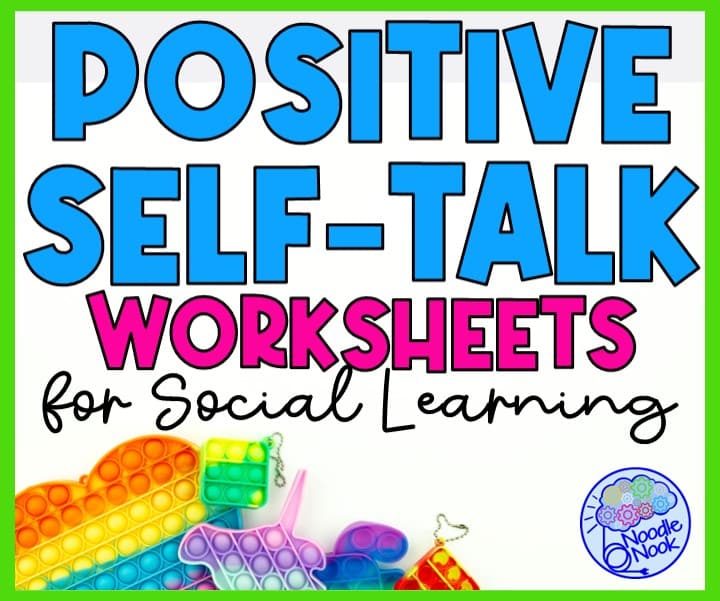
4. Use Positive Affirmations:
Positive affirmations are simple phrases that can help to counteract negative thoughts and to boost self-esteem. Encourage students to create a list of positive affirmations in a journal or with a positive self-talk worksheet. They can repeat the affirmations to themselves when they’re feeling down. These can be simple phrases such as “I am worthy,” “I am strong,” or “I am capable.”
Personalized Affirmations
One strategy that can be helpful is to have students personalize their affirmations, and make them specific to their own experiences and goals. For example, instead of saying “I am worthy,” they can say “I am worthy of love and respect” or “I am capable of achieving my goals”. These personal positive self-talk messages can replace the negative way a student may think and replace it with a specific positive phrase.
Visualizations
Another strategy is to have students choose one or two affirmations that are most meaningful to them. They then repeat them to themselves throughout the day. Encourage them to post them in a place where they can see them often. Some examples include on a sticky note on their bathroom mirror or on their phone’s lock screen. Seeing these new thoughts in the world can build up self esteem in students and also work as a great therapist aid.
Affirmations Sharing
As a class, you can also have affirmation-sharing sessions, where students can share their personal affirmations with each other, and discuss how they helped them in specific scenarios. This type of activity can usually turn into strengths-spotting exercises since students focus in on what they’re good at. They also have an opportunity to build camaraderie as they support one another.
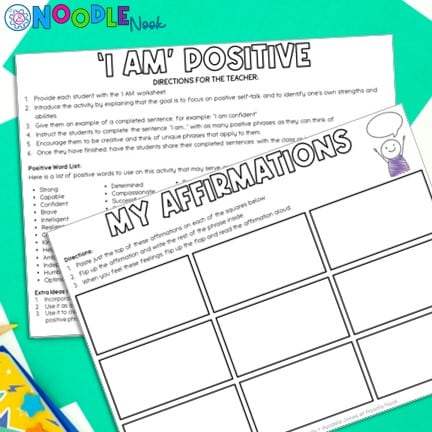
Be sure to remind students that affirmations are not magic, but when repeated consistently, they can help to shift their perspective and to change the way they think about themselves. Encourage them to be patient with themselves and to keep repeating the affirmations even when they don’t feel like they are working.
5. Focus on the Present Moment:
Negative self-talk often stems from worrying about the future or dwelling on the past. By focusing on the present moment, you can reduce negative self-talk and increase positive self-talk. Mindfulness practices such as meditation, yoga, or deep breathing can help to bring awareness to the present moment and to be more aware of your thoughts and feelings.
Daily Routine
One strategy that can be helpful is to incorporate mindfulness practices into your daily routine. For example, you can encourage students to take a few minutes each day to focus on their breath and to bring their attention to the present moment. This can be done while they are sitting in class, while they are walking to school, or even while they are brushing their teeth.
Mindfulness Exercises
Another strategy is to use mindfulness exercises that involve the senses, such as a body scan or progressive muscle relaxation. These exercises can help to focus the mind on the present moment and to reduce negative self-talk. As a class, you can have mindfulness sessions where you guide students through a mindfulness exercise. It can be a great way for them to relax, to focus on the present moment, and to reduce negative self-talk.
Remind students that mindfulness takes practice. Don’t be discouraged if they find it difficult at first. Encourage them to be patient with themselves and to keep trying different mindfulness exercises until they find what works for them.
RECAP: Positive Self-Talk
Negative self-talk can have a negative impact on one’s mental health and well-being. One can combat that by becoming aware of when it occurs and taking steps to challenge and reframe negative thoughts. Helping students learn to turn negative automatic thoughts into positive thinking is a critical life skill that you can address with simple positive self-talk worksheet activities. Incorporating strategies such as journaling, visualization, positive affirmations, and mindfulness practices can help to shift their perspective and change the way they think about themselves. Remember to consider your own teacher stress (read more here).
These strategies take time and practice to be effective, so be patient with your students and keep trying different techniques until you find what works for them. The good news is that with some consistency, you can support young children and young adults through both types of self-talk and work towards shifting their core beliefs. Remember, everyone deserves to be kind to themself and to treat themself with compassion, so keep working on building positive self-talk.

